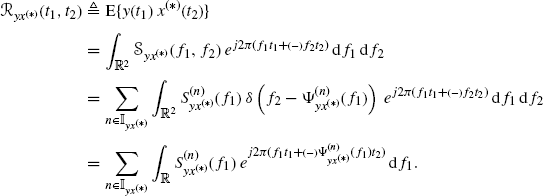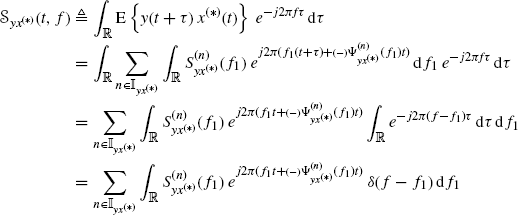5.1 Proofs for Section 4.2 “Characterization of SC Stochastic Processes”
5.1.1 Proof of Theorem 4.2.9 Second-Order Temporal Cross-Moment of Jointly SC Processes
Substituting (4.15) into (4.24b) and using the sampling property of the Dirac delta (Zemanian 1987, Section 1.7) leads to
By using the convolution theorem for the Fourier transform (Champeney 1990, Chapter 6) one obtains (4.24d).
5.1.2 Proof of Theorem 4.2.10 Time-Variant Cross-Spectrum of Jointly SC Processes
Starting from (5.1) with t1 = t + τ and t2 = t substituted into, one has
where, in the fourth equality the Fourier transform pair ![]() ↔ δ(f − f1) is used. Equation (4.27b) immediately follows from (5.2) by using the sampling property of Dirac delta (Zemanian 1987, Section 1.7).
↔ δ(f − f1) is used. Equation (4.27b) immediately follows from (5.2) by using the sampling property of Dirac delta (Zemanian 1987, Section 1.7).
5.1.3 Proof of (4.92)
Let ψ(·) be invertible and its inverse ϕ(·) differentiable. It results that (Zemanian 1987, Section 1.7)
(5.3) ![]()
Therefore
By using (4.91), (4.89), and (5.4), one has
from which (4.92) follows by using the ...
Get Generalizations of Cyclostationary Signal Processing: Spectral Analysis and Applications now with the O’Reilly learning platform.
O’Reilly members experience books, live events, courses curated by job role, and more from O’Reilly and nearly 200 top publishers.



